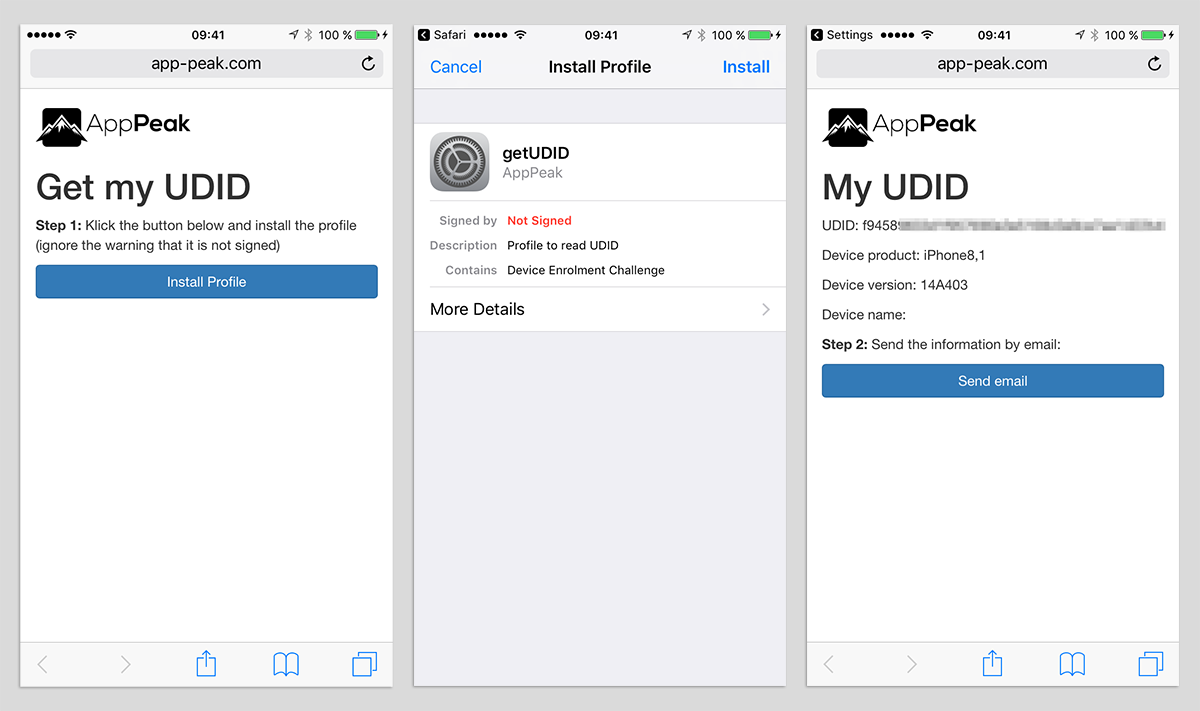
Easy Way to Get UDIDs Without iTunes
If you want to deploy iOS Apps via Ad-hoc distribution, you first have to know and register the UDIDs of your devices. It’s quite easy to find it in iTunes while connected with a cable, but it’s always a trouble to describe it to the average user – especially if you have many or don’t sit next to them.
How to avoid the trouble getting UDIDs
 Fortunately there is an easy way to find out the UDID directly on the device: with the help of a temporary profile, you get permission to read the device’s UDID (and other information). This has nothing to do with the Apps that used to be in the App Store some years ago – Apple stopped allowing developers to read the UDID from within an app.
Fortunately there is an easy way to find out the UDID directly on the device: with the help of a temporary profile, you get permission to read the device’s UDID (and other information). This has nothing to do with the Apps that used to be in the App Store some years ago – Apple stopped allowing developers to read the UDID from within an app.
For our solution we don’t need a specific app, but only a mobileconfig file and some php scripts.
There are some websites that facilitate the described temporary profile solution – also known as (Mobile) Configuration Profile. Just search for “get udid” and you find a ton. You just install the profile and allow the website to read the device information.
However, it’s somehow risky to allow an arbitrary website/developer to get such sensitive information. Even if you are not concerned, as a developer you probably still want to have a custom page that your customers or test users can use to give you their UDID.
Custom Configuration Profile and UDID page
So how do we build our own “Get my UDID” tool?
The concept is the following: you create a custom Configuration Profile (a XML file) that specifies the permissions to get the UDID and the destination (a php script) that is used to post the data to. With this at hand you only have to link the profile in a landing page and upload everything to your server (make sure to have php support).
Detailed information about this solution is scarce on the web, so I was happy to find this repo from hunk that had all the necessary files and scripts.
Here is what you do:
- Clone or download the get-UDID repo from hunk (https://github.com/hunk/get-UDID)
- Edit the “device.mobileconfig” file and change the url under PayloadContent > URL to your own.
- [Optional:] change the detail info of the mobileconfig as you like (organization name etc.) and style the pages.
- Upload everything to your server and make sure the url matches with the one of step 2.
- Use your iOS device to go to the landing page you have just uploaded (“index.html”) and follow the steps.
After warning you that the profile isn’t signed, you should be directed to the “show_detail.php” which shows your UDID and some other device information. You can use the link to directly send the UDID via email.
Setting up this site, makes it much easier to get users’ UDIDs. Hosting it yourself looks more professional and avoids any privacy/security concerns.
Let me know, if it worked for you or if you need any help.
– Moritz
-
Recent Posts
Categories
Tags
Ad-hoc distribution ads Analyze Android App Analytics App Icon app store App Store Optimization ASO Beginner Certificate Charts Configuration Profile consumables Conversion Daily Active Users DAU/MAU digital goods Downloads freemium IAP in app purchase iOS iPad iPhone iTunes iTunes Connect Keywords Metrics monetization money Monthly Active Users paid app Preview Video Slideshare Tips UDID

